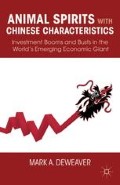Abstract
Smoothing investment fluctuations is a priority for central banks around the world. The People’s Bank of China (PBoC) is no exception. Its approach to macro-management is fundamentally different from that of its Western counterparts, however. The state’s dominant role in investment decision making and China’s inflexible foreign exchange rate regime make it difficult for the PBoC to use interest rate policy effectively. It must instead rely on more unconventional strategies to mitigate booms and busts.
The job of a good central banker is to take away the punch bowl just as the party gets going.
—Attributed to former Federal Reserve chairman William McChesney Martin
Access this chapter
Tax calculation will be finalised at checkout
Purchases are for personal use only
Preview
Unable to display preview. Download preview PDF.
Notes
People’s Bank of China, “Zhongguo Renmin Yinhang Huobi Zhengci Weiyuanhui Tiaolie” [People’s Bank of China Monetary Policy Committee Regulations], 2010, http://www.pbc.gov.cn/publish/huobizhengceersi/3416/2010/20100914145905843679838/20100914145905843679838_.html.
Roubini Global Economics, “China’s FX Reserves Break $3 Trillion: That’s One Expensive Peg!” April 15, 2011, http://relooney.fatcow.com/SI_FAO-Asia/0_Important_117.pdf.
Ba Shusong, and Xing Yujing, “Bianda Man Niu: Ping Yanghang Chabie Cunkuan Zhunbei Jinlu Zhengci” [Flogging a Slow Ox: On the Central Bank’s Differential Required Reserve Rate Policy]. China Finance 8 (2004): 23–25.
Shi Jinfeng, “40 Jia Difang Jinrong Jigou Bei Shishi Chabie Cunzhunlu: Zui Gao Shang Fu 3%” [Differential Required Reserve Rates Applied to 40 Local Financial Institutions: Increases as High as 3%]. 21st Century Business Herald, February 23, 2011, http://finance.sina.com.cn/roll/20110223/23289422481.shtml.
Zhan Xiangyang and Zheng Yanwen, “Chabie Cunkuan Zhunbeijin Lu Zhengci Toushe” [A Perspective on the Differential Reserve Rate Policy]. China Finance 5 (2011): 50–51.
Industrial and Commercial Bank of China, Global Offering Prospectus. 2006, 68.
People’s Bank of China, “China Monetary Policy Report Quarter Two, 2010,” August 5, 2010.
Wen Xiu, Yang Na, Chen Huiying, Zhao Jingting, and Ma Yuan, “How China’s Banks Risk Wealth Management Cash.” Caixin Online, July 21, 2011, http://english.caixin.cn/2011-07-21/100282196.html.
Liu Dong, “Qita Zichan Fengxian Quanzhong Cong 0% Tizhi 100%” [Risk Weighting for Other Assets Raised from 0% to 100%]. Diyi Caijing Ribao [First Financial Daily], August 17, 2011, http://www.21cbh.com/HTML/2011-8-17/xNMzcyXzM1NzkxNg.html.
You Xi, “9 Yue Mo 64 Jia Yinhang Rijun Cundai Bi Chaobiao: Liudongxing Fengxian Shangsheng” [Loan-Deposit Ratios at 64 Banks Exceed the Limit at the End of September: Liquidity Risk Rises]. Diyi Caijing Ribao [First Financial Daily], December 13, 2011, http://www.21cbh.com/HTML/2011-12-13/4NMzcyXzM4NzY4Nw.html.
Shanghai Securities Times, “Kongzhi Yinhang Bu Liang Zichan: Jiu Da Hangye Xindai Shou Yan Kong” [Controlling Banks’ Nonperforming Assets: Strict Controls on Credit to Nine Major Sectors], May 14, 2004, http://business.sohu.com/2004/05/14/01/article220120153.shtml.
Wang Lina, “Fangdichan Ye Hongguan Tiaokong Zhengce Tansuo” [An Exploration of the Real Estate Macroeconomic Adjustment Policy]. China Finance 15 (2004): 18.
He Jiangbin, “Yanghang Ling Shangye Yinhang Mingnian Zhuji Shangbao Xindai Jihua” [Central Bank Orders Commercial Banks to Submit Quarterly Credit Plans Next Year]. Huaxia Times, December 10, 2007, http://house.focus.cn/news/2007-12-10/406182.html.
Shanghai Securities Times, “Xindai Edu Qu Jin: Duo Jia Yinhang Yi Shangtiao Duo Xiang Daikuan Lilu” [Tight Credit Quotas: Many Banks Have Raised Interest Rates on a Variety of Loans], October 19, 2011, http://www.21cbh.com/HTML/2011-10-19/0NMzcxXzM3Mjc0Ng.html.
Shi Hongxiu, “Honggaun Tiaokong: Zai Xian You Tizhi Xia Youxiao de Zhengce” [Macroeconomic Adjustment: Effective Policies under the Present System], in Zhongguo Hongguan Tiaokong Sanshi Nian [Thirty Years of Macro-economic Adjustment in China], ed. Wei Kang (Beijing: Economic Science Press, 2008), 86.
Huaxia Times, “Xindai Edu: Zuihou Yi Yue Hai Sheng 6600 Wan” [Credit Quotas: 66 Million Remains in the Final Month], December 18, 2011, http://stock.sohu.com/20111218/n329393181.shtml.
Copyright information
© 2012 Mark A. DeWeaver
About this chapter
Cite this chapter
De Weaver, M.A. (2012). Taking Away the Ladle. In: Animal Spirits with Chinese Characteristics. Palgrave Macmillan, New York. https://doi.org/10.1057/9781137110121_7
Download citation
DOI: https://doi.org/10.1057/9781137110121_7
Publisher Name: Palgrave Macmillan, New York
Print ISBN: 978-1-349-29674-3
Online ISBN: 978-1-137-11012-1
eBook Packages: Palgrave Economics & Finance CollectionEconomics and Finance (R0)

